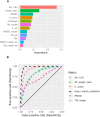Annotation of the Giardia proteome through structure-based homology and machine learning
- PMID: 30520990
- PMCID: PMC6312909
- DOI: 10.1093/gigascience/giy150
Annotation of the Giardia proteome through structure-based homology and machine learning
Abstract
Background: Large-scale computational prediction of protein structures represents a cost-effective alternative to empirical structure determination with particular promise for non-model organisms and neglected pathogens. Conventional sequence-based tools are insufficient to annotate the genomes of such divergent biological systems. Conversely, protein structure tolerates substantial variation in primary amino acid sequence and is thus a robust indicator of biochemical function. Structural proteomics is poised to become a standard part of pathogen genomics research; however, informatic methods are now required to assign confidence in large volumes of predicted structures.
Aims: Our aim was to predict the proteome of a neglected human pathogen, Giardia duodenalis, and stratify predicted structures into high- and lower-confidence categories using a variety of metrics in isolation and combination.
Methods: We used the I-TASSER suite to predict structural models for ∼5,000 proteins encoded in G. duodenalis and identify their closest empirically-determined structural homologues in the Protein Data Bank. Models were assigned to high- or lower-confidence categories depending on the presence of matching protein family (Pfam) domains in query and reference peptides. Metrics output from the suite and derived metrics were assessed for their ability to predict the high-confidence category individually, and in combination through development of a random forest classifier.
Results: We identified 1,095 high-confidence models including 212 hypothetical proteins. Amino acid identity between query and reference peptides was the greatest individual predictor of high-confidence status; however, the random forest classifier outperformed any metric in isolation (area under the receiver operating characteristic curve = 0.976) and identified a subset of 305 high-confidence-like models, corresponding to false-positive predictions. High-confidence models exhibited greater transcriptional abundance, and the classifier generalized across species, indicating the broad utility of this approach for automatically stratifying predicted structures. Additional structure-based clustering was used to cross-check confidence predictions in an expanded family of Nek kinases. Several high-confidence-like proteins yielded substantial new insight into mechanisms of redox balance in G. duodenalis-a system central to the efficacy of limited anti-giardial drugs.
Conclusion: Structural proteomics combined with machine learning can aid genome annotation for genetically divergent organisms, including human pathogens, and stratify predicted structures to promote efficient allocation of limited resources for experimental investigation.
Figures





References
-
- Karplus K, Barrett C, Hughey R. Hidden Markov models for detecting remote protein homologies. Bioinformatics. 1998;14:846–56. - PubMed
-
- Rost B. Twilight zone of protein sequence alignments. Protein Eng. 1999;12:85–94. - PubMed
-
- Illergård K, Ardell DH, Elofsson A. Structure is three to ten times more conserved than sequence—a study of structural response in protein cores. Proteins. 2009;77:499–508. - PubMed
-
- Morrison HG, McArthur AG, Gillin FD, et al. . Genomic minimalism in the early diverging intestinal parasite Giardialamblia. Science. 2007;317:1921–6. - PubMed
Publication types
MeSH terms
Substances
LinkOut - more resources
Full Text Sources

